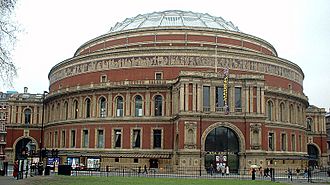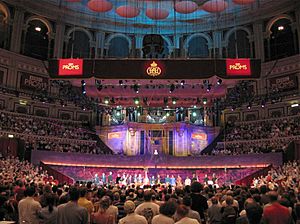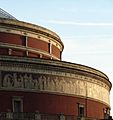Royal Albert Hall facts for kids
Quick facts for kids Royal Albert Hall |
|
|---|---|

The Royal Albert Hall, seen from Kensington Park
|
|
| General information | |
| Type | Concert Hall |
| Architectural style | Italianate |
| Address | Kensington Gore, South Kensington, London, SW7 2AP |
| Country | England, United Kingdom |
| Construction started | 18671 |
| Completed | 18711 |
| Inaugurated | 29 March 1871 |
| Cost | £200,0001 |
| Client | Queen Victoria |
| Height | 135 feet (41 m)2 |
| Design and construction | |
| Architect | Captain Francis Fowke and Major-General Henry Y.D. Scott of the Royal Engineers |
| Main contractor | Lucas Brothers |
| References | |
| 1 - Victorian London: Royal Albert Hall 2 - Royal Albert Hall, London |
|
The Royal Albert Hall of Arts and Sciences, often called the Albert Hall, is a very famous building in London, England. It opened in 1871. Queen Victoria opened the hall to honor her husband, Albert, Prince Consort. He had passed away ten years before. Today, it is a large auditorium where many different events take place.
The Royal Albert Hall is known all over the world. It hosts many kinds of events. You can see classical music concerts or pop music shows. There are also ballet performances, tennis matches, and even boxing events. Large ceremonies, parties, and conferences are held here too. Every summer, the famous BBC Proms concerts happen daily at the hall. The Royal Albert Hall has been holding concerts since 1941.
Contents
How Was the Royal Albert Hall Built?
In the early 1800s, the area where the hall now stands was mostly countryside. In 1851, a huge event called the Great Exhibition took place nearby. It was held in Hyde Park, right next to Kensington Park. The exhibition building, called Crystal Palace, was made of glass. It was only meant to be there for the exhibition.
Prince Albert's Big Idea
Prince Albert had a grand idea. He wanted to build public buildings in the area. These buildings would be for the arts and sciences. Because of his idea, several huge museums were built. These include the Science Museum, the Natural History Museum, and the Victoria and Albert Museum. When Prince Albert died in 1861, his plan had just begun. The Royal Albert Hall was built and named after him to finish his vision.
Laying the First Stone
The Royal Albert Hall is a very big building. In the past, up to 9,000 people could fit inside. Now, because of safety rules, about 5,500 people usually attend events. The building is round, like an ancient Greek or Roman amphitheatre. This is why the main floor area is called the "arena."
The hall has a very large glass and wrought-iron dome. This dome is 41 meters (135 feet) high. Around the outside, below the roof, there is a large mosaic picture. It shows "The Triumph of Arts and Sciences." There is also writing in terracotta letters. It says that Queen Victoria laid the first stone on May 20, 1867. She opened the hall on March 29, 1871. It also includes some words from the Bible. When Queen Victoria opened the building, she was so emotional she could not speak. Her son, Edward, the Prince of Wales, had to speak for her. He said: "The Queen declares this Hall is now open."
The Royal Albert Hall Through the Years
The hall has hosted many important events since 1871. Many of the seats are still owned by a group called "the Corporation of the Hall of Arts and Sciences." This group was formed in 1866 as a charity. They raised money to build the hall. Members of this group still have the right to use 1,300 of the 5,200 seats.
Solving the Echo Problem
For a long time, there was a problem with the sound inside the hall. There was too much echo. It was hard to hear music clearly. This problem was not fixed until 1969. Big fibreglass dishes were hung from the ceiling. People who visit the hall today often call them "mushrooms" or "flying saucers." These dishes make the music sound much better.
The Grand Organ
At the front of the hall, there is a very large pipe organ. It was first built by Henry Willis. Later, it was rebuilt by Harrison & Harrison and then by Mander Organs. It is the biggest organ in the British Isles. It has an amazing 9,997 pipes!
Home of the Proms
The Promenade Concerts began in 1895 by Henry Wood. They have been held at the Royal Albert Hall since 1941. This happened after the Queen's Hall was destroyed by bombs during World War II. For two months each summer, there is at least one concert every day. You can often see people lining up for standing tickets. They queue all the way down the steps towards Prince Consort Road.
When you go to the Proms today, you can choose where to sit or stand. You can stand in the arena, which is the flat area downstairs. Or you can sit in the stalls, which are seats around the arena. There are also Loggia Boxes, Second Tier Boxes, and the Circle (upstairs). The Choir area is behind the orchestra. You can also stand in the gallery, which is at the very top. For some events, like tennis matches or ballets, the action is in the arena. So, audience members do not sit or stand there.
Modern Updates and Improvements
In recent years, a lot of money has been spent to make the Royal Albert Hall even better. The 1,800 seats in the balcony, now called the "Circle," used to be uncomfortable. So, new, slightly bigger seats were put in. The south entrance has been made into the main entrance again, just like it was years ago. It now has a porch that matches the north entrance.
The area south of the hall has been closed to traffic. It is now a pedestrian-only area, which is safer for people walking. Dressing rooms, where artists get ready, are now on the stage level. Before, they were in the basement. There is also an underground car park and a loading area. This means that lorries bringing equipment do not need to unload in the street. This helps keep the streets clear and safe for visitors. Many other improvements have been made, including better ventilation to keep the air fresh.
Images for kids
-
Postcard of the Hall (c. 1903) with an inset of the Albert Memorial
-
The Hall with Kensington Gardens to the right
-
WWII Salute to the Red Army, February 1943
-
David Gilmour in 2015
-
Kylie Minogue was among the performers at The Queen's Birthday Party in 2018.
-
A prom seen from Circle R/S
-
Eric Clapton performing on stage at the Hall in May 2017
See also
 In Spanish: Royal Albert Hall para niños
In Spanish: Royal Albert Hall para niños





















